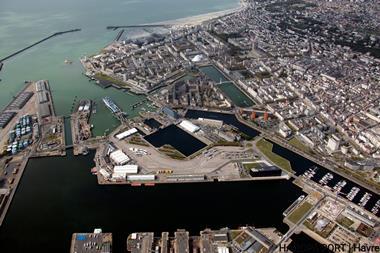Coordinating Ford’s complex service parts supply chain with minimal financial or asset waste requires an IT system that sets a global standard. The carmaker worked together with SAP and Caterpillar to create and implement a global solution
“I have two customers,” says Michael Czach, global inventory planning strategy manager in Ford’s Customer Service Division. “The customer in the repair bay and the shareholder – it’s my job to look after them both.”
 In principle, this should be relatively straightforward. “I need to maintain the required service level at the lowest total corporate cost,” he states simply.
In principle, this should be relatively straightforward. “I need to maintain the required service level at the lowest total corporate cost,” he states simply.
However, when the desired service level is a 98% piece fill rate, and you must fulfil 46m annual order lines for 4,300 dealers, sourcing 235,000 different parts from 2,800 suppliers through a network of 29 distribution centres, satisfying both customers is an extraordinarily demanding process. Especially as those figures apply just to Ford’s North American Business, its largest market worldwide. Unsurprisingly, everything, says Czach, needs to “work together like a symphony”.
“The planning department needs to create the best plan they can, and pass that plan as a ‘release’ to the merchandisers. They need to complete the operational planning and bring home that release. Then transportation, packaging and the warehouse all need to complete their roles within the required cycle time. The whole thing falls down if everybody doesn’t play their part,” he asserts.
While Ford’s service parts division is working to coordinate this elaborate process, it is also trying to do so with the fewest possible resources and the least investment. “I could buy five years worth of parts and stick them in a warehouse, but then I wouldn’t be fulfilling my responsibility to our shareholders,” says Czach. “So we are always striving for the fastest possible cycle times and the smallest lots from the supplier.”
The secrets of service parts
Any company trying to run a complex, modern supply chain with the minimum waste, depends on the right IT system. At Ford, the solution of choice is the Service Parts Management module of the SAP business suite. That’s no surprise, since Ford itself played a central role in the development of the system. “A lot of our customers started out by using our manufacturing planning and optimisation solutions for their service parts businesses,” explains Bryan Charnock, director of service parts solutions at SAP.
“That approach worked, but they found they were having to do quite a lot of customisation to get the service-parts-specific functionality they needed. Ten or twelve years ago, Ford and Caterpillar’s logistics services division came together to us with the suggestion that we could develop something specially designed for service parts. We agreed that rather than build a custom solution for them, we would use their requirements and their insights to develop a standard product.”
That development process has been ongoing ever since, and Ford is midway through a roll out of the system to its global parts network. “We already have one implementation running in Europe, we are rolling out in the US at the moment and then we plan to move on to Asia, “ explains Czach.
The capabilities of SAP’s service parts solution can be thought of in three steps, says Charnock. Step one is parts planning and procurement, whereby a company decides what quantities of which parts it will need when. Step two is warehousing; the company decides on the best location to store those parts in its distribution network relative to their likely demand. The final step is fulfilment, in which parts are shipped to the end customer.
The power of the dedicated software starts with the forecasting of probable demand for each part. The SAP Service Parts Planning module uses historical demand data to predict future demand levels for 99% of Ford’s parts, says Czach, noting that the system is smart to enough to continually compare actual demand with its forecast, and to automatically update future forecasts or alert Ford’s planners if demand for a certain part starts to drift away from expectations.
Completed forecasts are handed over to Ford’s inventory planning department where the economic order quantity, safety stock, and stocking strategies are managed. They do this using a highly segmented strategy, in which different rules for order quantities, timings, stock locations and safety stock levels are assigned to different categories of parts, depending on the overall level of demand for the part and its criticality.
“Twenty years ago we just had high, medium and low volume segments,” says Czach. “Today we have more than ten different volume classifications and we also segment by order frequency and the cost of the part, which leads to hundreds of different segments.”
The segmentation strategy is a powerful compromise for Ford’s planners. By grouping parts with similar characteristics together, they relieve themselves of the unfeasibly time-consuming and expensive task of creating a separate strategy for every one of the thousands of parts they must manage, while at the same time, the ability to define numerous segments allows the company to create inventory strategies that are pretty close to ideal for the majority of parts, despite widely differing costs, production requirements and patterns of actual demand.
"Twenty years ago we just had high, medium and low volume segments. Today we have more than ten volume classifications and we also segment by order frequency and the cost of the part" – Michael Czach, Ford
Overriding logic
Even with the this level of automation offered by the SAP system, however, there are still occasions when the company’s business knowledge experience needs to override the relentless logic of the computer. One such case is that of new model launches. “When a new vehicle enters the market, we won’t have historical data on demand for parts,” notes Czach. “The SAP system has phase-in curves to forecast demand for new parts, but at the same time it is really important for us that if someone damages their brand new vehicle, we are able to provide the parts to get it back on the road, so we will always have an initial buy, regardless of demand and we will probably use a higher than normal safety stock level initially to make sure that happens.”

Once actual demand levels become clearer, the planning for new parts can transfer to the highly automated standard process. “Once we have more than three or four consecutive periods of non-zero demand, we will hand the part over to the inventory planning department.”
With its inventory plans in place, the Ford team needs to take the action required to get the parts it needs into the right warehouse at the right time. For this, they use SAP’s Distribution Requirements Planning capabilities, the latest part of the SAP Implementation to go live in North America.
“DRP is a fairly simple process, just a giant template that lines things up in the time series. You could do it on a spread sheet if you wanted,” says Czach. “If my forecast suggests I’m going to reach my minimum safety stock level for a part in August and I know that it take two months from order to delivery to replenish that part, my DRP system will make sure I order more parts in June.”
The importance of the system, he notes, is its ability to carry out these simple calculations for thousands of different parts, and to integrate seamlessly with the inventory planning and forecasting systems, and with suppliers via EDI.
Once the orders for parts have been placed, says Czach, it is up to staff in the merchandising function to “bring home” that release. As in the planning phase, it is the way an organisation handles the exceptions – those occasions where demand peaks unexpectedly, or where a supplier fails to provide the requested parts – that really determines the overall performance of the system.
“There are lots of ways we use the SAP system to monitor exceptions,” explains Czach. “The system is set up to alert us if anything unexpected happens and we constantly monitor cycle times to check they are meeting our requirements.”
If the system identifies a potential issue with parts, Ford’s planners have a range of countermeasures available to them. “We can change our safety stock strategy, for example. If the situation gets really critical, we have an inbound monitor which we can use to alter the sequence in which trucks arrive at our warehouses and how quickly they are unloaded, which lets us expedite the transport of critical parts.”
As well as giving Ford the best chance of dealing effectively with unpredictable events, the SAP system also helps it spot and fix more systematic part supply issues. “We have detailed supplier performance scorecards and if a supplier is consistently underperforming, our supplier development department can go in and help them improve,” says Czach. “We also have an out-of-tolerance process, which automatically identifies those parts where actual demand is consistently the furthest from the forecast and we will manually forecast those parts.”
The future development of Ford’s service parts strategy is bound up with the company’s One Ford strategy. While Europe currently runs its own independent SAP installation, the rest of the world will launch on the US installation. “We already have 80% of the parts for our Canada market running on our system, and we are gradually transferring the rest,” says Czach.
The ambition of eventually running Ford’s entire global service parts business on a single database promises to deliver a host of advantages. Today, Ford’s various markets around the world create their own demand for service parts, Czach explains. This leads to unnecessary cost by disguising the true underlying patterns of demand and letting different regions build their own independent estimates for safety stocks into their requests.

A fully globalised approach also offers advantages for suppliers. “Our suppliers really want a single order from Ford, rather than requests for multiple releases from multiple entities,” he says. “They also want to use the same processes regardless of which part of the organisation they deal with, not different processes for different markets.”
According to SAP’s Bryan Charnock, integrating a complete service parts business in a single ERP system offers other operational advantages for companies. “One of the capabilities our system offers is called ‘global availability to promise’,” he says. “That means that if you have a shortage, or a big order that you can’t fulfil from your local stocks, you can look across your entire network and see if you can fill it from anywhere else, or you can use substitution rules to see if there is another part that could be used instead.”
Continuing developments
While SAP is no longer developing its service parts module just for Ford and Caterpillar, its two original customers still have a big influence on the on-going evolution of the system, says Charnock. “Those two companies have been using the system for the longest and they are still extremely important customers, so we certainly think about them, talk to them and listen to them when we are planning new features.”
Looking toward advances in the system, Charnock points to growing interest from customers in the automotive and other sectors in the real time capture of demand signals. “Imagine how useful it would be if your service parts system didn’t have to wait until the dealerships placed their orders for parts to know what the next week’s demand was going to be, but could collect that data directly from the job information entered by the mechanic when the car goes into the dealership. That kind of real-time information is creating a lot of excitement in the CPG [consumer packaged goods] space right now, and we can see significant opportunities for it in automotive too.”
Charnock says that automotive could also follow things that other sectors are doing in service parts, including the ‘repair or buy’ strategies used in the aerospace sector, where high value parts like landing gear may be removed from aircraft and stored ready to be overhauled and prepared for re-use only when they are needed. Such approaches may not seem particularly appropriate for the automotive sector today, but in a future of high commodity prices and tighter environmental regulation, it is not unfeasible that remanufactured parts might take a much more prominent role in the automotive aftermarket supply chain too.






















